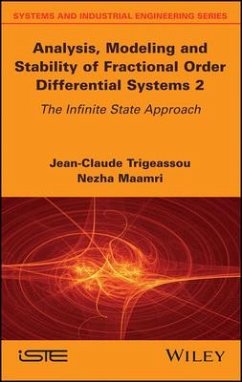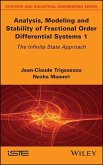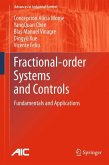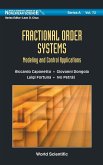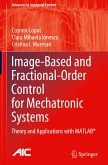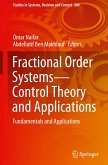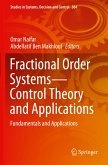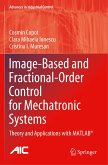Jean-Claude Trigeassou, Nezha Maamri
Analysis, Modeling and Stability of Fractional Order Differential Systems 2
The Infinite State Approach
Jean-Claude Trigeassou, Nezha Maamri
Analysis, Modeling and Stability of Fractional Order Differential Systems 2
The Infinite State Approach
- Gebundenes Buch
- Merkliste
- Auf die Merkliste
- Bewerten Bewerten
- Teilen
- Produkt teilen
- Produkterinnerung
- Produkterinnerung
This book introduces an original fractional calculus methodology (�the infinite state approach�) which is applied to the modeling of fractional order differential equations (FDEs) and systems (FDSs). Its modeling is based on the frequency distributed fractional integrator, while the resulting model corresponds to an integer order and infinite dimension state space representation. This original modeling allows the theoretical concepts of integer order systems to be generalized to fractional systems, with a particular emphasis on a convolution formulation. With this approach, fundamental issues…mehr
Andere Kunden interessierten sich auch für
![Analysis, Modeling and Stability of Fractional Order Differential Systems 1 Analysis, Modeling and Stability of Fractional Order Differential Systems 1]() Jean-Claude TrigeassouAnalysis, Modeling and Stability of Fractional Order Differential Systems 1187,99 €
Jean-Claude TrigeassouAnalysis, Modeling and Stability of Fractional Order Differential Systems 1187,99 €![Fractional-order Systems and Controls Fractional-order Systems and Controls]() Concepción A. MonjeFractional-order Systems and Controls81,99 €
Concepción A. MonjeFractional-order Systems and Controls81,99 €![FRACTIONAL ORDER SYSTEMS (V72) FRACTIONAL ORDER SYSTEMS (V72)]() Riccardo Caponetto Et AlFRACTIONAL ORDER SYSTEMS (V72)119,99 €
Riccardo Caponetto Et AlFRACTIONAL ORDER SYSTEMS (V72)119,99 €![Image-Based and Fractional-Order Control for Mechatronic Systems Image-Based and Fractional-Order Control for Mechatronic Systems]() Cosmin CopotImage-Based and Fractional-Order Control for Mechatronic Systems100,99 €
Cosmin CopotImage-Based and Fractional-Order Control for Mechatronic Systems100,99 €![Fractional Order Systems-Control Theory and Applications Fractional Order Systems-Control Theory and Applications]() Fractional Order Systems-Control Theory and ApplicationsFractional Order Systems-Control Theory and Applications116,99 €
Fractional Order Systems-Control Theory and ApplicationsFractional Order Systems-Control Theory and Applications116,99 €![Fractional Order Systems-Control Theory and Applications Fractional Order Systems-Control Theory and Applications]() Fractional Order Systems-Control Theory and Applications116,99 €
Fractional Order Systems-Control Theory and Applications116,99 €![Image-Based and Fractional-Order Control for Mechatronic Systems Image-Based and Fractional-Order Control for Mechatronic Systems]() Cosmin CopotImage-Based and Fractional-Order Control for Mechatronic Systems77,99 €
Cosmin CopotImage-Based and Fractional-Order Control for Mechatronic Systems77,99 €-
-
-
This book introduces an original fractional calculus methodology (�the infinite state approach�) which is applied to the modeling of fractional order differential equations (FDEs) and systems (FDSs). Its modeling is based on the frequency distributed fractional integrator, while the resulting model corresponds to an integer order and infinite dimension state space representation. This original modeling allows the theoretical concepts of integer order systems to be generalized to fractional systems, with a particular emphasis on a convolution formulation. With this approach, fundamental issues such as system state interpretation and system initialization - long considered to be major theoretical pitfalls - have been solved easily. Although originally introduced for numerical simulation and identification of FDEs, this approach also provides original solutions to many problems such as the initial conditions of fractional derivatives, the uniqueness of FDS transients, formulation of analytical transients, fractional differentiation of functions, state observation and control, definition of fractional energy, and Lyapunov stability analysis of linear and nonlinear fractional order systems. This second volume focuses on the initialization, observation and control of the distributed state, followed by stability analysis of fractional differential systems.
Hinweis: Dieser Artikel kann nur an eine deutsche Lieferadresse ausgeliefert werden.
Hinweis: Dieser Artikel kann nur an eine deutsche Lieferadresse ausgeliefert werden.
Produktdetails
- Produktdetails
- Verlag: Wiley
- Seitenzahl: 432
- Erscheinungstermin: 26. Februar 2020
- Englisch
- Abmessung: 236mm x 157mm x 30mm
- Gewicht: 794g
- ISBN-13: 9781786304551
- ISBN-10: 1786304554
- Artikelnr.: 58296946
- Herstellerkennzeichnung
- Libri GmbH
- Europaallee 1
- 36244 Bad Hersfeld
- gpsr@libri.de
- Verlag: Wiley
- Seitenzahl: 432
- Erscheinungstermin: 26. Februar 2020
- Englisch
- Abmessung: 236mm x 157mm x 30mm
- Gewicht: 794g
- ISBN-13: 9781786304551
- ISBN-10: 1786304554
- Artikelnr.: 58296946
- Herstellerkennzeichnung
- Libri GmbH
- Europaallee 1
- 36244 Bad Hersfeld
- gpsr@libri.de
Jean-Claude Trigeassou is Honorary Professor at Bordeaux University, France, and has been associated with the research activities of its IMS-LAPS lab since 2006. His main research interests include the modeling of fractional order systems, based on the infinite state approach. Nezha Maamri is Associate Professor at Poitiers University, France. Her research activities concern the method of moments, robust control using integer order and fractional order controllers, plus the modeling, initialization and stability of fractional order systems.
Foreword xiii Preface xv Part 1. Initialization, State Observation and Control 1 Chapter 1. Initialization of Fractional Order Systems 3 1.1. Introduction 3 1.2. Initialization of an integer order differential system 4 1.2.1. Introduction 4 1.2.2. Response of a linear system 4 1.2.3. Input/output solution 6 1.2.4. State space solution 7 1.2.5. First-order system example 8 1.3. Initialization of a fractional differential equation 10 1.3.1. Introduction 10 1.3.2. Free response of a simple FDE 10 1.4. Initialization of a fractional differential system 14 1.4.1. Introduction 14 1.4.2. State space representation 14 1.4.3. Input/output formulation 15 1.5. Some initialization examples 17 1.5.1. Introduction 17 1.5.2. Initialization of the fractional integrator 17 1.5.3. Initialization of the Riemann-Liouville derivative 19 1.5.4. Initialization of an elementary FDS 21 1.5.5. Conclusion 33 Chapter 2. Observability and Controllability of FDEs/FDSs 35 2.1. Introduction 35 2.2. A survey of classical approaches to the observability and controllability of fractional differential systems 37 2.2.1. Introduction 37 2.2.2. Definition of observability and controllability 37 2.2.3. Observability and controllability criteria for a linear integer order system 37 2.2.4. Observability and controllability of FDS 39 2.3. Pseudo-observability and pseudo-controllability of an FDS 40 2.3.1. Introduction 40 2.3.2. Elementary approach 41 2.3.3. Cayley-Hamilton approach 45 2.3.4. Gramian approach 49 2.3.5. Gilbert's approach 52 2.3.6. Conclusion 57 2.3.7. Pseudo-controllability example 58 2.4. Observability and controllability of the distributed state 60 2.4.1. Introduction 60 2.4.2. Observability of the distributed state 62 2.4.3. Controllability of the distributed state 64 2.5. Conclusion 65 Chapter 3. Improved Initialization of Fractional Order Systems 67 3.1. Introduction 67 3.2. Initialization: problem statement 68 3.3. Initialization with a fractional observer 71 3.3.1. Fractional observer definition 71 3.3.2. Stability analysis 72 3.3.3. Convergence analysis 74 3.3.4. Numerical example 1: one-derivative system 76 3.3.5. Numerical example 2: non-commensurate order system 78 3.4. Improved initialization 81 3.4.1. Introduction 81 3.4.2. Non-commensurate order principle 82 3.4.3. Gradient algorithm 84 3.4.4. One-derivative FDE example 87 3.4.5. Two-derivative FDE example 91 A.3. Appendix 95 A.3.1. Convergence of gradient algorithm 95 A.3.2. Stability and limit value of
98 Chapter 4. State Control of Fractional Differential Systems 99 4.1. Introduction 99 4.2. Pseudo-state control of an FDS 100 4.2.1. Introduction 100 4.2.2. Numerical simulation example 101 4.3. State control of the elementary FDE 103 4.3.1. Introduction 103 4.3.2. State control of a fractional integrator 104 4.4. State control of an FDS 121 4.4.1. Introduction 121 4.4.2. Principle of state control 122 4.4.3. State control of two integrators in series 124 4.4.4. Numerical example 126 4.4.5. State control of a two-derivative FDE 129 4.4.6. Pseudo-state control of the two-derivative FDE 130 4.5. Conclusion 131 Chapter 5. Fractional Model-based Control of the Diffusive RC Line 133 5.1. Introduction 133 5.2. Identification of the RC line using a fractional model 134 5.2.1. Introduction 134 5.2.2. An identification algorithm dedicated to fractional models 134 5.2.3. Simulation of the diffusive RC line 139 5.2.4. Experimental identification 149 5.3. Reset of the RC line 154 5.3.1. Introduction 154 5.3.2. Natural relaxation 155 5.3.3. Principle of the reset technique 156 5.3.4. Proposed reset procedure 158 5.3.5. Experimental results 159 5.3.6. Comments 164 5.3.7. Conclusion 165 Part 2. Stability of Fractional Differential Equations and Systems 167 Chapter 6. Stability of Linear FDEs Using the Nyquist Criterion 169 6.1. Introduction 169 6.2. Simulation and stability of fractional differential equations 171 6.2.1. Simulation of an FDE 171 6.2.2. Stability of the simulation scheme 172 6.2.3. Stability analysis of FDEs using the Nyquist criterion 174 6.3. Stability of ordinary differential equations 175 6.3.1. Introduction 175 6.3.2. Open-loop transfer function 176 6.3.3. Drawing of H OL (j
) graph in the complex plane 177 6.3.4. Stability of the third-order ODE 178 6.3.5. Conclusion 182 6.4. Stability analysis of FDEs 182 6.4.1. Introduction 182 6.4.2. Drawing of H OL (j
) graph in the complex plane 182 6.4.3. Stability of the one-derivative FDE 184 6.4.4. Stability of the two-derivative FDE 187 6.4.5. Stability of the N-derivative FDE 194 6.4.6. Conclusion 195 6.5. Stability analysis of ODEs with time delays 195 6.5.1. Introduction 195 6.5.2. Definitions 196 6.5.3. Stability analysis 196 6.5.4. Application to an example 198 6.6. Stability analysis of FDEs with time delays 200 6.6.1. Definitions 200 6.6.2. Stability 201 6.6.3. Application to an example 202 Chapter 7. Fractional Energy 205 7.1. Introduction 205 7.2. Pseudo-energy stored in a fractional integrator 206 7.3. Energy stored and dissipated in a fractional integrator 211 7.3.1. Introduction 211 7.3.2. Electrical distributed network 211 7.3.3. Stored energy 214 7.3.4. Power dissipated in the fractional integrator 215 7.3.5. Energy storage 216 7.3.6. Integer order and fractional order integrators 219 7.3.7. Characterization of fractional energy and its dissipation 226 7.3.8. Fractional energy invariance 231 7.4. Closed-loop and open-loop fractional energies 234 7.4.1. Introduction 234 7.4.2. Energy of the closed-loop model 234 7.4.3. Energy of the open-loop model 237 7.4.4. Stored energies with a step input excitation 239 Chapter 8. Lyapunov Stability of Commensurate Order Fractional Systems 247 8.1. Introduction 247 8.2. Lyapunov stability of a one-derivative FDE 249 8.2.1. Problem statement 249 8.2.2. Numerical simulation 251 8.2.3. Physical interpretation 253 8.2.4. Theoretical interpretation 254 8.3. Lyapunov stability of an N-derivative FDE 258 8.3.1. Introduction 258 8.3.2. The integer order case 258 8.3.3. Lyapunov function of N-derivative systems 261 8.3.4. Stability condition 265 8.4. Lyapunov stability of a two-derivative commensurate order FDE 269 8.4.1. Introduction 269 8.4.2. State space model of the open-loop representation 270 8.4.3. State space models of the closed-loop representation 271 8.4.4. Energy and stability of the open-loop representation 272 8.4.5. Energy and stability of the closed-loop representation 274 8.4.6. Definition of a stability test for a > 0 276 8.5. Lyapunov stability of an N-derivative FDE ( N > 2 ) 281 8.5.1. Introduction 281 8.5.2. Problem statement 282 8.5.3. LMI generalization for N = 3 283 8.5.4. Application example 289 A.8. Appendix 290 A.8.1. Lemma 290 A.8.2. Matignon's criterion 291 Chapter 9. Lyapunov Stability of Non-commensurate Order Fractional Systems 293 9.1. Introduction 293 9.2. Stored energy, dissipation and energy balance in fractional electrical devices 295 9.2.1. Usual capacitor and inductor devices 295 9.2.2. Fractional capacitor and inductor 296 9.2.3. Energy storage and dissipation in fractional devices 299 9.2.4. Reversibility of energy and energy balance 301 9.3. The usual series RLC circuit 302 9.3.1. Introduction 302 9.3.2. Analysis of the series RLC circuit 302 9.3.3. Stability analysis 304 9.4. The series RLC* fractional circuit 306 9.4.1. Introduction 306 9.4.2. Analysis of the series RLC* circuit 306 9.4.3. Experimental stability analysis 307 9.4.4. Theoretical stability analysis 310 9.4.5. Conclusion 314 9.5. The series RLL*C* circuit 315 9.5.1. Circuit modeling 315 9.5.2. Stability analysis 317 9.6. The series RL*C* fractional circuit 320 9.6.1. Introduction 320 9.6.2. Analysis of the series RL*C* circuit 320 9.6.3. Theoretical stability analysis 322 9.7. Stability of a commensurate order FDE: energy balance approach 325 9.7.1. Introduction 325 9.7.2. Analysis of the commensurate order FDE 325 9.7.3. Application to stability 327 9.8. Stability of a commensurate order FDE: physical interpretation of the usual approach 328 9.8.1. Introduction 328 9.8.2. Commensurate order system 329 9.8.3. Lyapunov function of a fractional differential system 329 9.8.4. Stability analysis 331 9.8.5. Conclusion 334 A.9. Appendix 335 A.9.1. The infinite length LG line 335 A.9.2. Energy storage and dissipation in the fractional capacitor 339 A.9.3. Some integrals 341 Chapter 10. An Introduction to the Lyapunov Stability of Nonlinear Fractional Order Systems 343 10.1. Introduction 343 10.2. Indirect Lyapunov method 344 10.2.1. Introduction 344 10.2.2. Linearization 344 10.2.3. Nonlinear system analysis 345 10.2.4. Local stability of a one-derivative nonlinear fractional system 349 10.3. Lyapunov direct method 353 10.3.1. Introduction 353 10.3.2. The variable gradient method 353 10.3.3. Nonlinear system with one derivative 354 10.3.4. Nonlinear system with two fractional derivatives 357 10.4. The Van der Pol oscillator 363 10.4.1. Electrical nonlinear system 363 10.4.2. Van der Pol oscillator 364 10.4.3. Simulation of the nonlinear system 364 10.4.4. Limit cycle 365 10.5. Analysis of local stability 366 10.5.1. Linearization 366 10.5.2. Local stability 367 10.5.3. Validation of stability results 369 10.6. Large signal analysis 371 10.6.1. Introduction 371 10.6.2. Approximation of the first harmonic [MUL 09] 371 10.6.3. Lyapunov function and oscillation frequency 372 10.6.4. Amplitude of the limit cycle 372 10.6.5. Prediction of the limit cycle 374 References 377 Index 395
98 Chapter 4. State Control of Fractional Differential Systems 99 4.1. Introduction 99 4.2. Pseudo-state control of an FDS 100 4.2.1. Introduction 100 4.2.2. Numerical simulation example 101 4.3. State control of the elementary FDE 103 4.3.1. Introduction 103 4.3.2. State control of a fractional integrator 104 4.4. State control of an FDS 121 4.4.1. Introduction 121 4.4.2. Principle of state control 122 4.4.3. State control of two integrators in series 124 4.4.4. Numerical example 126 4.4.5. State control of a two-derivative FDE 129 4.4.6. Pseudo-state control of the two-derivative FDE 130 4.5. Conclusion 131 Chapter 5. Fractional Model-based Control of the Diffusive RC Line 133 5.1. Introduction 133 5.2. Identification of the RC line using a fractional model 134 5.2.1. Introduction 134 5.2.2. An identification algorithm dedicated to fractional models 134 5.2.3. Simulation of the diffusive RC line 139 5.2.4. Experimental identification 149 5.3. Reset of the RC line 154 5.3.1. Introduction 154 5.3.2. Natural relaxation 155 5.3.3. Principle of the reset technique 156 5.3.4. Proposed reset procedure 158 5.3.5. Experimental results 159 5.3.6. Comments 164 5.3.7. Conclusion 165 Part 2. Stability of Fractional Differential Equations and Systems 167 Chapter 6. Stability of Linear FDEs Using the Nyquist Criterion 169 6.1. Introduction 169 6.2. Simulation and stability of fractional differential equations 171 6.2.1. Simulation of an FDE 171 6.2.2. Stability of the simulation scheme 172 6.2.3. Stability analysis of FDEs using the Nyquist criterion 174 6.3. Stability of ordinary differential equations 175 6.3.1. Introduction 175 6.3.2. Open-loop transfer function 176 6.3.3. Drawing of H OL (j
) graph in the complex plane 177 6.3.4. Stability of the third-order ODE 178 6.3.5. Conclusion 182 6.4. Stability analysis of FDEs 182 6.4.1. Introduction 182 6.4.2. Drawing of H OL (j
) graph in the complex plane 182 6.4.3. Stability of the one-derivative FDE 184 6.4.4. Stability of the two-derivative FDE 187 6.4.5. Stability of the N-derivative FDE 194 6.4.6. Conclusion 195 6.5. Stability analysis of ODEs with time delays 195 6.5.1. Introduction 195 6.5.2. Definitions 196 6.5.3. Stability analysis 196 6.5.4. Application to an example 198 6.6. Stability analysis of FDEs with time delays 200 6.6.1. Definitions 200 6.6.2. Stability 201 6.6.3. Application to an example 202 Chapter 7. Fractional Energy 205 7.1. Introduction 205 7.2. Pseudo-energy stored in a fractional integrator 206 7.3. Energy stored and dissipated in a fractional integrator 211 7.3.1. Introduction 211 7.3.2. Electrical distributed network 211 7.3.3. Stored energy 214 7.3.4. Power dissipated in the fractional integrator 215 7.3.5. Energy storage 216 7.3.6. Integer order and fractional order integrators 219 7.3.7. Characterization of fractional energy and its dissipation 226 7.3.8. Fractional energy invariance 231 7.4. Closed-loop and open-loop fractional energies 234 7.4.1. Introduction 234 7.4.2. Energy of the closed-loop model 234 7.4.3. Energy of the open-loop model 237 7.4.4. Stored energies with a step input excitation 239 Chapter 8. Lyapunov Stability of Commensurate Order Fractional Systems 247 8.1. Introduction 247 8.2. Lyapunov stability of a one-derivative FDE 249 8.2.1. Problem statement 249 8.2.2. Numerical simulation 251 8.2.3. Physical interpretation 253 8.2.4. Theoretical interpretation 254 8.3. Lyapunov stability of an N-derivative FDE 258 8.3.1. Introduction 258 8.3.2. The integer order case 258 8.3.3. Lyapunov function of N-derivative systems 261 8.3.4. Stability condition 265 8.4. Lyapunov stability of a two-derivative commensurate order FDE 269 8.4.1. Introduction 269 8.4.2. State space model of the open-loop representation 270 8.4.3. State space models of the closed-loop representation 271 8.4.4. Energy and stability of the open-loop representation 272 8.4.5. Energy and stability of the closed-loop representation 274 8.4.6. Definition of a stability test for a > 0 276 8.5. Lyapunov stability of an N-derivative FDE ( N > 2 ) 281 8.5.1. Introduction 281 8.5.2. Problem statement 282 8.5.3. LMI generalization for N = 3 283 8.5.4. Application example 289 A.8. Appendix 290 A.8.1. Lemma 290 A.8.2. Matignon's criterion 291 Chapter 9. Lyapunov Stability of Non-commensurate Order Fractional Systems 293 9.1. Introduction 293 9.2. Stored energy, dissipation and energy balance in fractional electrical devices 295 9.2.1. Usual capacitor and inductor devices 295 9.2.2. Fractional capacitor and inductor 296 9.2.3. Energy storage and dissipation in fractional devices 299 9.2.4. Reversibility of energy and energy balance 301 9.3. The usual series RLC circuit 302 9.3.1. Introduction 302 9.3.2. Analysis of the series RLC circuit 302 9.3.3. Stability analysis 304 9.4. The series RLC* fractional circuit 306 9.4.1. Introduction 306 9.4.2. Analysis of the series RLC* circuit 306 9.4.3. Experimental stability analysis 307 9.4.4. Theoretical stability analysis 310 9.4.5. Conclusion 314 9.5. The series RLL*C* circuit 315 9.5.1. Circuit modeling 315 9.5.2. Stability analysis 317 9.6. The series RL*C* fractional circuit 320 9.6.1. Introduction 320 9.6.2. Analysis of the series RL*C* circuit 320 9.6.3. Theoretical stability analysis 322 9.7. Stability of a commensurate order FDE: energy balance approach 325 9.7.1. Introduction 325 9.7.2. Analysis of the commensurate order FDE 325 9.7.3. Application to stability 327 9.8. Stability of a commensurate order FDE: physical interpretation of the usual approach 328 9.8.1. Introduction 328 9.8.2. Commensurate order system 329 9.8.3. Lyapunov function of a fractional differential system 329 9.8.4. Stability analysis 331 9.8.5. Conclusion 334 A.9. Appendix 335 A.9.1. The infinite length LG line 335 A.9.2. Energy storage and dissipation in the fractional capacitor 339 A.9.3. Some integrals 341 Chapter 10. An Introduction to the Lyapunov Stability of Nonlinear Fractional Order Systems 343 10.1. Introduction 343 10.2. Indirect Lyapunov method 344 10.2.1. Introduction 344 10.2.2. Linearization 344 10.2.3. Nonlinear system analysis 345 10.2.4. Local stability of a one-derivative nonlinear fractional system 349 10.3. Lyapunov direct method 353 10.3.1. Introduction 353 10.3.2. The variable gradient method 353 10.3.3. Nonlinear system with one derivative 354 10.3.4. Nonlinear system with two fractional derivatives 357 10.4. The Van der Pol oscillator 363 10.4.1. Electrical nonlinear system 363 10.4.2. Van der Pol oscillator 364 10.4.3. Simulation of the nonlinear system 364 10.4.4. Limit cycle 365 10.5. Analysis of local stability 366 10.5.1. Linearization 366 10.5.2. Local stability 367 10.5.3. Validation of stability results 369 10.6. Large signal analysis 371 10.6.1. Introduction 371 10.6.2. Approximation of the first harmonic [MUL 09] 371 10.6.3. Lyapunov function and oscillation frequency 372 10.6.4. Amplitude of the limit cycle 372 10.6.5. Prediction of the limit cycle 374 References 377 Index 395
Foreword xiii Preface xv Part 1. Initialization, State Observation and Control 1 Chapter 1. Initialization of Fractional Order Systems 3 1.1. Introduction 3 1.2. Initialization of an integer order differential system 4 1.2.1. Introduction 4 1.2.2. Response of a linear system 4 1.2.3. Input/output solution 6 1.2.4. State space solution 7 1.2.5. First-order system example 8 1.3. Initialization of a fractional differential equation 10 1.3.1. Introduction 10 1.3.2. Free response of a simple FDE 10 1.4. Initialization of a fractional differential system 14 1.4.1. Introduction 14 1.4.2. State space representation 14 1.4.3. Input/output formulation 15 1.5. Some initialization examples 17 1.5.1. Introduction 17 1.5.2. Initialization of the fractional integrator 17 1.5.3. Initialization of the Riemann-Liouville derivative 19 1.5.4. Initialization of an elementary FDS 21 1.5.5. Conclusion 33 Chapter 2. Observability and Controllability of FDEs/FDSs 35 2.1. Introduction 35 2.2. A survey of classical approaches to the observability and controllability of fractional differential systems 37 2.2.1. Introduction 37 2.2.2. Definition of observability and controllability 37 2.2.3. Observability and controllability criteria for a linear integer order system 37 2.2.4. Observability and controllability of FDS 39 2.3. Pseudo-observability and pseudo-controllability of an FDS 40 2.3.1. Introduction 40 2.3.2. Elementary approach 41 2.3.3. Cayley-Hamilton approach 45 2.3.4. Gramian approach 49 2.3.5. Gilbert's approach 52 2.3.6. Conclusion 57 2.3.7. Pseudo-controllability example 58 2.4. Observability and controllability of the distributed state 60 2.4.1. Introduction 60 2.4.2. Observability of the distributed state 62 2.4.3. Controllability of the distributed state 64 2.5. Conclusion 65 Chapter 3. Improved Initialization of Fractional Order Systems 67 3.1. Introduction 67 3.2. Initialization: problem statement 68 3.3. Initialization with a fractional observer 71 3.3.1. Fractional observer definition 71 3.3.2. Stability analysis 72 3.3.3. Convergence analysis 74 3.3.4. Numerical example 1: one-derivative system 76 3.3.5. Numerical example 2: non-commensurate order system 78 3.4. Improved initialization 81 3.4.1. Introduction 81 3.4.2. Non-commensurate order principle 82 3.4.3. Gradient algorithm 84 3.4.4. One-derivative FDE example 87 3.4.5. Two-derivative FDE example 91 A.3. Appendix 95 A.3.1. Convergence of gradient algorithm 95 A.3.2. Stability and limit value of
98 Chapter 4. State Control of Fractional Differential Systems 99 4.1. Introduction 99 4.2. Pseudo-state control of an FDS 100 4.2.1. Introduction 100 4.2.2. Numerical simulation example 101 4.3. State control of the elementary FDE 103 4.3.1. Introduction 103 4.3.2. State control of a fractional integrator 104 4.4. State control of an FDS 121 4.4.1. Introduction 121 4.4.2. Principle of state control 122 4.4.3. State control of two integrators in series 124 4.4.4. Numerical example 126 4.4.5. State control of a two-derivative FDE 129 4.4.6. Pseudo-state control of the two-derivative FDE 130 4.5. Conclusion 131 Chapter 5. Fractional Model-based Control of the Diffusive RC Line 133 5.1. Introduction 133 5.2. Identification of the RC line using a fractional model 134 5.2.1. Introduction 134 5.2.2. An identification algorithm dedicated to fractional models 134 5.2.3. Simulation of the diffusive RC line 139 5.2.4. Experimental identification 149 5.3. Reset of the RC line 154 5.3.1. Introduction 154 5.3.2. Natural relaxation 155 5.3.3. Principle of the reset technique 156 5.3.4. Proposed reset procedure 158 5.3.5. Experimental results 159 5.3.6. Comments 164 5.3.7. Conclusion 165 Part 2. Stability of Fractional Differential Equations and Systems 167 Chapter 6. Stability of Linear FDEs Using the Nyquist Criterion 169 6.1. Introduction 169 6.2. Simulation and stability of fractional differential equations 171 6.2.1. Simulation of an FDE 171 6.2.2. Stability of the simulation scheme 172 6.2.3. Stability analysis of FDEs using the Nyquist criterion 174 6.3. Stability of ordinary differential equations 175 6.3.1. Introduction 175 6.3.2. Open-loop transfer function 176 6.3.3. Drawing of H OL (j
) graph in the complex plane 177 6.3.4. Stability of the third-order ODE 178 6.3.5. Conclusion 182 6.4. Stability analysis of FDEs 182 6.4.1. Introduction 182 6.4.2. Drawing of H OL (j
) graph in the complex plane 182 6.4.3. Stability of the one-derivative FDE 184 6.4.4. Stability of the two-derivative FDE 187 6.4.5. Stability of the N-derivative FDE 194 6.4.6. Conclusion 195 6.5. Stability analysis of ODEs with time delays 195 6.5.1. Introduction 195 6.5.2. Definitions 196 6.5.3. Stability analysis 196 6.5.4. Application to an example 198 6.6. Stability analysis of FDEs with time delays 200 6.6.1. Definitions 200 6.6.2. Stability 201 6.6.3. Application to an example 202 Chapter 7. Fractional Energy 205 7.1. Introduction 205 7.2. Pseudo-energy stored in a fractional integrator 206 7.3. Energy stored and dissipated in a fractional integrator 211 7.3.1. Introduction 211 7.3.2. Electrical distributed network 211 7.3.3. Stored energy 214 7.3.4. Power dissipated in the fractional integrator 215 7.3.5. Energy storage 216 7.3.6. Integer order and fractional order integrators 219 7.3.7. Characterization of fractional energy and its dissipation 226 7.3.8. Fractional energy invariance 231 7.4. Closed-loop and open-loop fractional energies 234 7.4.1. Introduction 234 7.4.2. Energy of the closed-loop model 234 7.4.3. Energy of the open-loop model 237 7.4.4. Stored energies with a step input excitation 239 Chapter 8. Lyapunov Stability of Commensurate Order Fractional Systems 247 8.1. Introduction 247 8.2. Lyapunov stability of a one-derivative FDE 249 8.2.1. Problem statement 249 8.2.2. Numerical simulation 251 8.2.3. Physical interpretation 253 8.2.4. Theoretical interpretation 254 8.3. Lyapunov stability of an N-derivative FDE 258 8.3.1. Introduction 258 8.3.2. The integer order case 258 8.3.3. Lyapunov function of N-derivative systems 261 8.3.4. Stability condition 265 8.4. Lyapunov stability of a two-derivative commensurate order FDE 269 8.4.1. Introduction 269 8.4.2. State space model of the open-loop representation 270 8.4.3. State space models of the closed-loop representation 271 8.4.4. Energy and stability of the open-loop representation 272 8.4.5. Energy and stability of the closed-loop representation 274 8.4.6. Definition of a stability test for a > 0 276 8.5. Lyapunov stability of an N-derivative FDE ( N > 2 ) 281 8.5.1. Introduction 281 8.5.2. Problem statement 282 8.5.3. LMI generalization for N = 3 283 8.5.4. Application example 289 A.8. Appendix 290 A.8.1. Lemma 290 A.8.2. Matignon's criterion 291 Chapter 9. Lyapunov Stability of Non-commensurate Order Fractional Systems 293 9.1. Introduction 293 9.2. Stored energy, dissipation and energy balance in fractional electrical devices 295 9.2.1. Usual capacitor and inductor devices 295 9.2.2. Fractional capacitor and inductor 296 9.2.3. Energy storage and dissipation in fractional devices 299 9.2.4. Reversibility of energy and energy balance 301 9.3. The usual series RLC circuit 302 9.3.1. Introduction 302 9.3.2. Analysis of the series RLC circuit 302 9.3.3. Stability analysis 304 9.4. The series RLC* fractional circuit 306 9.4.1. Introduction 306 9.4.2. Analysis of the series RLC* circuit 306 9.4.3. Experimental stability analysis 307 9.4.4. Theoretical stability analysis 310 9.4.5. Conclusion 314 9.5. The series RLL*C* circuit 315 9.5.1. Circuit modeling 315 9.5.2. Stability analysis 317 9.6. The series RL*C* fractional circuit 320 9.6.1. Introduction 320 9.6.2. Analysis of the series RL*C* circuit 320 9.6.3. Theoretical stability analysis 322 9.7. Stability of a commensurate order FDE: energy balance approach 325 9.7.1. Introduction 325 9.7.2. Analysis of the commensurate order FDE 325 9.7.3. Application to stability 327 9.8. Stability of a commensurate order FDE: physical interpretation of the usual approach 328 9.8.1. Introduction 328 9.8.2. Commensurate order system 329 9.8.3. Lyapunov function of a fractional differential system 329 9.8.4. Stability analysis 331 9.8.5. Conclusion 334 A.9. Appendix 335 A.9.1. The infinite length LG line 335 A.9.2. Energy storage and dissipation in the fractional capacitor 339 A.9.3. Some integrals 341 Chapter 10. An Introduction to the Lyapunov Stability of Nonlinear Fractional Order Systems 343 10.1. Introduction 343 10.2. Indirect Lyapunov method 344 10.2.1. Introduction 344 10.2.2. Linearization 344 10.2.3. Nonlinear system analysis 345 10.2.4. Local stability of a one-derivative nonlinear fractional system 349 10.3. Lyapunov direct method 353 10.3.1. Introduction 353 10.3.2. The variable gradient method 353 10.3.3. Nonlinear system with one derivative 354 10.3.4. Nonlinear system with two fractional derivatives 357 10.4. The Van der Pol oscillator 363 10.4.1. Electrical nonlinear system 363 10.4.2. Van der Pol oscillator 364 10.4.3. Simulation of the nonlinear system 364 10.4.4. Limit cycle 365 10.5. Analysis of local stability 366 10.5.1. Linearization 366 10.5.2. Local stability 367 10.5.3. Validation of stability results 369 10.6. Large signal analysis 371 10.6.1. Introduction 371 10.6.2. Approximation of the first harmonic [MUL 09] 371 10.6.3. Lyapunov function and oscillation frequency 372 10.6.4. Amplitude of the limit cycle 372 10.6.5. Prediction of the limit cycle 374 References 377 Index 395
98 Chapter 4. State Control of Fractional Differential Systems 99 4.1. Introduction 99 4.2. Pseudo-state control of an FDS 100 4.2.1. Introduction 100 4.2.2. Numerical simulation example 101 4.3. State control of the elementary FDE 103 4.3.1. Introduction 103 4.3.2. State control of a fractional integrator 104 4.4. State control of an FDS 121 4.4.1. Introduction 121 4.4.2. Principle of state control 122 4.4.3. State control of two integrators in series 124 4.4.4. Numerical example 126 4.4.5. State control of a two-derivative FDE 129 4.4.6. Pseudo-state control of the two-derivative FDE 130 4.5. Conclusion 131 Chapter 5. Fractional Model-based Control of the Diffusive RC Line 133 5.1. Introduction 133 5.2. Identification of the RC line using a fractional model 134 5.2.1. Introduction 134 5.2.2. An identification algorithm dedicated to fractional models 134 5.2.3. Simulation of the diffusive RC line 139 5.2.4. Experimental identification 149 5.3. Reset of the RC line 154 5.3.1. Introduction 154 5.3.2. Natural relaxation 155 5.3.3. Principle of the reset technique 156 5.3.4. Proposed reset procedure 158 5.3.5. Experimental results 159 5.3.6. Comments 164 5.3.7. Conclusion 165 Part 2. Stability of Fractional Differential Equations and Systems 167 Chapter 6. Stability of Linear FDEs Using the Nyquist Criterion 169 6.1. Introduction 169 6.2. Simulation and stability of fractional differential equations 171 6.2.1. Simulation of an FDE 171 6.2.2. Stability of the simulation scheme 172 6.2.3. Stability analysis of FDEs using the Nyquist criterion 174 6.3. Stability of ordinary differential equations 175 6.3.1. Introduction 175 6.3.2. Open-loop transfer function 176 6.3.3. Drawing of H OL (j
) graph in the complex plane 177 6.3.4. Stability of the third-order ODE 178 6.3.5. Conclusion 182 6.4. Stability analysis of FDEs 182 6.4.1. Introduction 182 6.4.2. Drawing of H OL (j
) graph in the complex plane 182 6.4.3. Stability of the one-derivative FDE 184 6.4.4. Stability of the two-derivative FDE 187 6.4.5. Stability of the N-derivative FDE 194 6.4.6. Conclusion 195 6.5. Stability analysis of ODEs with time delays 195 6.5.1. Introduction 195 6.5.2. Definitions 196 6.5.3. Stability analysis 196 6.5.4. Application to an example 198 6.6. Stability analysis of FDEs with time delays 200 6.6.1. Definitions 200 6.6.2. Stability 201 6.6.3. Application to an example 202 Chapter 7. Fractional Energy 205 7.1. Introduction 205 7.2. Pseudo-energy stored in a fractional integrator 206 7.3. Energy stored and dissipated in a fractional integrator 211 7.3.1. Introduction 211 7.3.2. Electrical distributed network 211 7.3.3. Stored energy 214 7.3.4. Power dissipated in the fractional integrator 215 7.3.5. Energy storage 216 7.3.6. Integer order and fractional order integrators 219 7.3.7. Characterization of fractional energy and its dissipation 226 7.3.8. Fractional energy invariance 231 7.4. Closed-loop and open-loop fractional energies 234 7.4.1. Introduction 234 7.4.2. Energy of the closed-loop model 234 7.4.3. Energy of the open-loop model 237 7.4.4. Stored energies with a step input excitation 239 Chapter 8. Lyapunov Stability of Commensurate Order Fractional Systems 247 8.1. Introduction 247 8.2. Lyapunov stability of a one-derivative FDE 249 8.2.1. Problem statement 249 8.2.2. Numerical simulation 251 8.2.3. Physical interpretation 253 8.2.4. Theoretical interpretation 254 8.3. Lyapunov stability of an N-derivative FDE 258 8.3.1. Introduction 258 8.3.2. The integer order case 258 8.3.3. Lyapunov function of N-derivative systems 261 8.3.4. Stability condition 265 8.4. Lyapunov stability of a two-derivative commensurate order FDE 269 8.4.1. Introduction 269 8.4.2. State space model of the open-loop representation 270 8.4.3. State space models of the closed-loop representation 271 8.4.4. Energy and stability of the open-loop representation 272 8.4.5. Energy and stability of the closed-loop representation 274 8.4.6. Definition of a stability test for a > 0 276 8.5. Lyapunov stability of an N-derivative FDE ( N > 2 ) 281 8.5.1. Introduction 281 8.5.2. Problem statement 282 8.5.3. LMI generalization for N = 3 283 8.5.4. Application example 289 A.8. Appendix 290 A.8.1. Lemma 290 A.8.2. Matignon's criterion 291 Chapter 9. Lyapunov Stability of Non-commensurate Order Fractional Systems 293 9.1. Introduction 293 9.2. Stored energy, dissipation and energy balance in fractional electrical devices 295 9.2.1. Usual capacitor and inductor devices 295 9.2.2. Fractional capacitor and inductor 296 9.2.3. Energy storage and dissipation in fractional devices 299 9.2.4. Reversibility of energy and energy balance 301 9.3. The usual series RLC circuit 302 9.3.1. Introduction 302 9.3.2. Analysis of the series RLC circuit 302 9.3.3. Stability analysis 304 9.4. The series RLC* fractional circuit 306 9.4.1. Introduction 306 9.4.2. Analysis of the series RLC* circuit 306 9.4.3. Experimental stability analysis 307 9.4.4. Theoretical stability analysis 310 9.4.5. Conclusion 314 9.5. The series RLL*C* circuit 315 9.5.1. Circuit modeling 315 9.5.2. Stability analysis 317 9.6. The series RL*C* fractional circuit 320 9.6.1. Introduction 320 9.6.2. Analysis of the series RL*C* circuit 320 9.6.3. Theoretical stability analysis 322 9.7. Stability of a commensurate order FDE: energy balance approach 325 9.7.1. Introduction 325 9.7.2. Analysis of the commensurate order FDE 325 9.7.3. Application to stability 327 9.8. Stability of a commensurate order FDE: physical interpretation of the usual approach 328 9.8.1. Introduction 328 9.8.2. Commensurate order system 329 9.8.3. Lyapunov function of a fractional differential system 329 9.8.4. Stability analysis 331 9.8.5. Conclusion 334 A.9. Appendix 335 A.9.1. The infinite length LG line 335 A.9.2. Energy storage and dissipation in the fractional capacitor 339 A.9.3. Some integrals 341 Chapter 10. An Introduction to the Lyapunov Stability of Nonlinear Fractional Order Systems 343 10.1. Introduction 343 10.2. Indirect Lyapunov method 344 10.2.1. Introduction 344 10.2.2. Linearization 344 10.2.3. Nonlinear system analysis 345 10.2.4. Local stability of a one-derivative nonlinear fractional system 349 10.3. Lyapunov direct method 353 10.3.1. Introduction 353 10.3.2. The variable gradient method 353 10.3.3. Nonlinear system with one derivative 354 10.3.4. Nonlinear system with two fractional derivatives 357 10.4. The Van der Pol oscillator 363 10.4.1. Electrical nonlinear system 363 10.4.2. Van der Pol oscillator 364 10.4.3. Simulation of the nonlinear system 364 10.4.4. Limit cycle 365 10.5. Analysis of local stability 366 10.5.1. Linearization 366 10.5.2. Local stability 367 10.5.3. Validation of stability results 369 10.6. Large signal analysis 371 10.6.1. Introduction 371 10.6.2. Approximation of the first harmonic [MUL 09] 371 10.6.3. Lyapunov function and oscillation frequency 372 10.6.4. Amplitude of the limit cycle 372 10.6.5. Prediction of the limit cycle 374 References 377 Index 395

